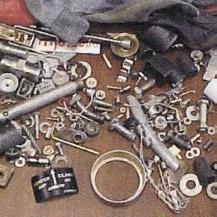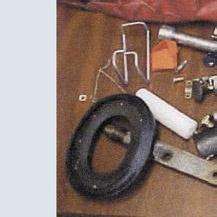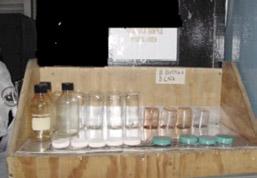
16 minute read
Crossfeed
Maintenance Officer
LCdr. Bert Ortiz bert.ortiz@navy.mil
Advertisement
Editorial Coordinator
AMC(AW) Paul Hofstad paul.hofstad@navy.mil
Airframes
Best Practice in the Fleet—Ingenuity at Work Within VFA-211 By AMC(AW) Paul Hofstad
Normally, when we write our articles for Mech, we focus on a problem we see in the fleet. This article is different; it announces that airframers in VFA-211 have developed a new concept to fix an old problem regarding hydraulic contamination.
Surveys routinely reveal problems with the way commands drain their sample bottles after performing patch tests. One of the CSEC questions asks if sample bottles are clean and transparent. Approximately half the commands we look at do not have a designated area to drain their bottles after using the patch-test kit. Instead, they just put the bottles back into the kit, with residual fluid still in them. Other commands have a method to drain their bottles, but it is not very effective because they turn the bottles upside down and place them directly on poly-wipes. This method sometimes works, but more times than not, commands leave the poly-wipes in place until they are full of hydraulic fluid and become a hazmat issue.
Airframers at VFA-211 designed a platform that allows bottles to drain with a canted catch pan under the table. The fluid then collects at a drain in the lowest point of the catch pan. At the drain, a hose is attached that allows the fluid to drain into a bucket. The drain table is not used solely for patchtest-kit bottles. They also use it for their electronicparticle-counter sample bottles.
These young men and women used their resources to overcome a problem with both hazmat and hydraulic contamination. They thought outside The drain hose is to the right of the EPC with the bucket below the EPC stand. Everything is behind a protective barrier.
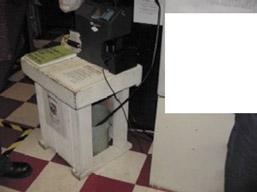
the box and have developed an outstanding hydraulic station.
Chief Hofstad is a maintenance analyst at the Naval Safety Center.
Keep Your Guard Down
By AMC(AW) Paul Hofstad
After being assigned to the Naval Safety Center for a little over a year now, I’m still learning there’s a lot of room for improvement in the way maintenance is performed in the Navy. One issue in particular is the correct operation of mechanical or hydraulic shears. These shears normally are found in Navy AIMDs and Marine MALS. In larger squadrons, shears also can be found in the airframes work center.
Mechanical and hydraulic shears primarily are used to cut large sections of sheet metal. When the handle is pulled down or the foot pedal is depressed, a large guard comes down; then, the shears come down to cut the metal.
Here is where the problem begins. When the guard comes down, the maximum distance allowed between the metal or plate and the bottom of the guard is one-quarter inch. This clearance is designed to keep our hands from entering the cutting section (point of operation) of the job.
CFR 1910.212(a)1 states, “Machine guarding shall be provided to protect employees in the machine area from hazards such as those created by point of operation, nip points, rotating parts, flying chips, and sparks.” Furthermore, “The pointof-operation guarding device shall be so designed as to prevent the operator from having any part of his body in the danger zone during the operating cycle.” Shears are one of many machines that require guarding.
This article would not be complete without a sea story to emphasize the need to use guards on our shears. I recently walked into an airframes shop at an AIMD we surveyed and told the LPO that the guards on his hydraulic shears were set too high. I did not need my safe-distance scale or a ruler, for that matter, to tell that the distance between the plate and the guard was too high. But, to be on the safe side, I measured the gap anyway and found the distance was set at approximately two inches. I’m not the smartest person in the world, but I know that if those shears can cut three-eights-inch thick sheet metal, they certainly can remove my fingers.
The LPO, however, wanted to argue with me. His whole argument was that the manufacturer of the shears had set the gap on the piece of equipment, and if the manufacturer set it, then it must be right. Wrong! The point of guarding machinery is to protect our folks. Finally, the LPO disgustedly blurted out, “Chief, I wish you would have looked at us a few weeks ago. One of my guys was using those shears, lost track of what he was doing, and chopped off the ends of his fingers.”
Sometimes, we just need to measure things with common sense. Most folks can get their entire hand between a two-inch gap. Our job as supervisors is to recognize safety problems and act on them. I’m sure the LPO was unfamiliar with the Code of Federal Regulations. But I am equally sure that we all have the ability to ask questions and not let down our guard.
Chief Hofstad is a maintenance analyst at the Naval Safety Center.
Ordnance
Ordie Material—Did You Know?
By AOCS(AW) Fred Christian
The NAVAIR 01-700 Airborne Weapons/Stores Manuals Checklists Publication Index is published/distributed quarterly; it is a NATEC Electronic Manual. Oddly enough, I am finding that a few dispersed technical publication librarians (DTPLs) and, in some cases, even the central technical publication librarian (CTPL) have no idea how to use the manual. Our Sailors and Marines must have current references with the most recent information. It is equally important to ensure that the NA 01-700 is current. If neither the CTPL nor the DTPL know what this item is used for, then they
probably don’t know whether their loading manuals and checklists are current. Make sure the right personnel are assigned to the appropriate duties. Incomplete checklists (pages missing)—changes or Interim Rapid Action Changes (IRACS) not incorporated or improperly incorporated are some of the deficiencies found during surveys.
This index is designed to provide using activities with a guide to ensure that all existing changes or revisions have been incorporated in aircraft conventional weapon loading, release and control, airborne weapon support equipment (AWSE), and weapon assembly/disassembly checklists and manuals on hand. In the event of a conflict with dates between the index and associated publications, the most current date shall take precedence. Publications and checklists with issue dates after the release date of this index take precedence over earlier releases and will be added to this index during the next update. In addition to the above information, the publication index provides other information, as well. It provides point-of-contact information for applicable aircraft and weapon-loading manuals and checklists. It also lists deleted publications.
Another recurring TPL deficiency is activities not having the current Explosive Safety Technical Manual (ESTM) CD or NAVSEA ordnance-related publications. The ESTM (formerly ESTD) CD is an excellent source of required/recommended NAVSEA publications, such as your basic OP4 and 5. The current version of the ESTM CD is dated 15 August 2005. Naval Ordnance Safety and Security Activity (NOSSA) point of contact for distribution of explosives safety-related publications is Mr. John Majka, NAVSURFWARCENDIV Indian Head Detachment Earle, Code 7121JM, commercial (732) 866-2923 (DSN 449-2923), or e-mail john.majka@navy.mil.
The Weapons and Explosive Safety Newsletter provides current information and status on the ESTM CD, as well as pending changes and revisions to individual NAVSEA ordnance publications. It is published quarterly. Your POC at NOSSA for distribution is Mr. Donata Dow at (301) 744-6048 (DSN 354-6048), or e-mail donata.dow@navy.mil. This newsletter is a vital source of information that can enhance explosives-safety awareness at all levels. In addition to excellent ordnance-related articles, the newsletter contains other information: status of NAVSEA Explosives Safety Technical Manuals, Explosives Safety Courses/AOOCP calendar, Conventional Ordnance Safety Review/Explosive Safety Inspection, (COSR/ESI) findings and common discrepancies, and NOSSA points of contact.
Many command librarians, both CTPL and DTPL, have ESTM CDs but are not aware of what publications they contain. The librarians often don’t know they have paper copies of the same publications, which sometimes are not current. Aside from the NAVSEA OP4 and OP5, a variety of other publications, directives, and information is provided. It is recommended that you list each publication that is on the CD individually in the CTPL listing.
About four out of five activities surveyed had NAVSEA or other ordnance-related publications or instructions that were either obsolete or not current (missing changes or revisions). Here are some other publications that deserve mentioning. In the past six months to one year, the following discrepancies were found:
NAVSEA OP2239 (some still found in ord truck glove boxes), and NAVSEA OP3681 superseded by SW020-AF-ABK-010,
NAVSEA OP4461 superseded by SW023- AG-WHM-010, NAVSEA OP4098 superseded by SW023-AH-WHM-010, ESTD CDs dated as far back as January 1999.
These are all examples of publications that were superseded by more current publications many years ago. Many people probably are aware of this, but some still don’t know.
Some NAVSEA, SWO and NAVSUP publications can be ordered through the NAVSUP Naval Logistics Library (NLL) website: http://www.nll.navsup.navy.mil. A limited number can be viewed online. The Naval Operational Logistics Support Center (NOLSC) (formerly NALC) publishes the NAVSUP P-800 Ordnance Publications CD bi-annually in April and October. Questions regarding distribution should be submitted via e-mail to mech_nolsc_nardesk@navy.mil.
Other common discrepancies among instructions are: OPNAVINST 8600.2 is now 8000.16B. OPNAVINST 8000.16A is now 8000.16B. OPNAVINST 5530.13B is now 5530.13C.
I could go on, but that’s a whole different article. Meanwhile, ordies, keep the powder dry.
Senior Chief Christian is an explosives/weapons analyst at the Naval Safety Center.
WESS Update

The WESS Barrier Removal Team (BRT) is working to improve the program. Help us make WESS better, use the on-screen feedback form or call the WESS help desk at 757-444-7048. Let’s work together and tell us what we can do to help.
Workcenter Leadership
Where Has All the Leadership Gone?
By AMCS(AW/SW) Cheryl Poirier
At the risk of dating myself, there was an anti-war song, “Where Have All the Flowers Gone,” sung by Peter Paul and Mary that I used to sing when I was growing up. The last line in the last stanza is “When will we ever learn, when will we ever learn?” We continue to crash aircraft and kill and injure both aircrew and maintainers because of maintenance errors, so I ask you, “Where has all the leadership gone? When will we ever learn?”
Maintenance-related mishap is a phrase that makes the hair on the back of my neck stand up. In previous maintenance-related A/B mishaps, fellow knuckle-draggers have contributed to the loss or damage of a multi-million-dollar aircraft and the injury or death of squadronmates. A recent analysis revealed the top four Class A/B maintenance-related causal factors for 61 mishaps analyzed (FY99-04).
Maintenance-Related Mishap Causal Factors Top 4:
No. 4. Quality Assurance—19 instances
No. 3. Lack of Communication—22 instances
No. 2. Attention Failure—37 instances (stress, fatigue, improper documentation, judgment error, decision error, overconfidence, motivation misplaced or excessive).
And the number 1 reason we crash aircraft and kill Sailors…
No. 1. Failure to Follow Procedure—53
instances (failed to use/follow PUB and/or directives, technical information incomplete or confusing, failed to follow W/C procedures, failed to follow safety procedures).
When I was stationed on the USS Harry S. Truman, I was strolling through the hangar bay and came upon a young Sailor standing on an overturned trash can, no cranial, impact goggles protecting the top of his head, getting ready to drill a hole above his “protected” head into the aircraft. I think I did a double take and uttered a couple of four-letter expletives because I couldn’t believe what he was getting ready to do. I found his supervisor holding up the workcenter bulkhead, counting sheep. The first question I asked him when his eyeballs were able to focus was where his chief was so we could go explain the situation to him.
During a recent survey, I observed fellow airframers jacking an aircraft. The CDI was in front directing, but no pub could be found, and the aircraft wasn’t roped off.
While checking tools on another survey, I found a tool missing a part. I found the chief in the shop surfing the net and told him about what the NAMP defines as a missing tool. He told me his guys would get to it when they got back to the shop. I had to pick up my chin off my chest as I watched him nonchalantly go back to surfing the net.
From my perspective as a senior chief, with 20 years in the Navy, it looks to me that all the preceding factors and the sea stories could be related directly to leadership, or the lack thereof. How many planes do we have to crash, and how many people do we have to kill before we start doing things right? Now, don’t get your knickers in a twist; I’m not pointing fingers at anyone specifically. We are all to blame. I bet if you brainstormed, you could come up with a lot of ways to avoid these “top four.” Here is what I came up with:
No. 1. LBWA, Leadership By Walking Around. Know what your people are doing.
No. 2. Use the correct publications, procedures, and protective equipment.
No. 3. Know your people and their capabilities.
No. 4. Communicate, communicate, communicate.
No. 5. Quality maintenance—If you feel really comfortable performing a job or acting as a CDI, take a step back and re-evaluate. Comfort can lead to complacency.
No. 6. ORM—It is a way of life both on and off duty.
If you’re not a part of the solution, you’re part of the problem. Together, we can keep flying birds off the pointy end, dropping warheads on foreheads, and sleep soundly at night, knowing the aircrew will come home because we did our jobs right.
Senior Chief Poirier is a maintenance analyst at the Naval Safety Center.
Crane Safety
Category 3 Crane Operator’s Safety Course Just Got Easier
By ASCS(AW) Phil LeCroy
One of the most useful tools in the inventory is the category 3 crane (overhead-mounted crane), which is found in most hangars. This device can be used to move helicopter blades, aircraft engines, supplies, and support equipment. Too many operators, however, are not aware that a safety course is required before using these cranes.
SECNAVINST 11260.2 assigns Commander, Naval Facilities Engineering Command the overall responsibility of directing and overseeing the Department of the Navy’s weight-handling program attend. A problem has developed when a class is held on one coast (say San Diego), and the student is stationed on the East Coast. The required per diem ($320 per student) doesn’t paint a pretty picture.
The Navy recognized this issue and developed a course that is available at Navy Knowledge Online (NKO).
The on-line course takes about eight hours to complete, and a test is given at the conclusion. Successful course takers will earn a completion certificate.
for shore commands. CNO message 291049Z Oct 97 directs Navy shore-activity commanders to ensure that weight-handling equipment is maintained in strict compliance with NAVFAC (Naval Facilities) Manual P-307. They also must support the Navy Crane Center (NCC) in implementing P-307. The requirement for the crane course is found in Chapter 13 of the manual and clearly states it must be completed before operating any category 3 cranes.
These courses are held at any one of the seven Navy Crane Centers. Prospective students need to submit an enrollment request, wait for confirmation, receive a class convening date, get orders cut, and
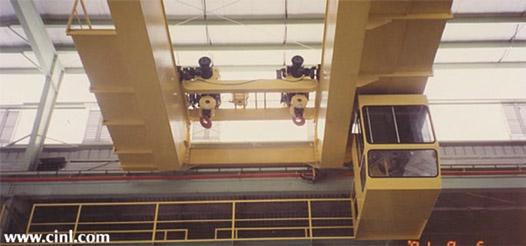
However, they also must meet OJT requirements and demonstrate proficiency to a qualified operator. Once finished and once paperwork has been routed for endorsements and authorizing signature, the student is a qualified operator.
The cost savings are obvious, but, more importantly, trained operators will reduce the number of “Do not use” labels found on some cranes due to cable entanglement (bird nests) and other problems caused by untrained operators. Reducing non-RFI time on the cranes improves the command’s efficiency.
Senior Chief LeCroy is a maintenance analyst assigned to the Naval Safety Center.
Class C Mishap Summary
By AMC(AW) Paul Hofstad
From July 1 through Sept. 30, 2005, the Navy and Marine Corps had 42 Class C mishaps that involved 40 aircraft. The damage total was $2,338,873.
During maintenance checks on an E-2C, the flap actuator damaged the starboard aileron. The aircraft had been downed for stuck flaps the night before the mishap, and initial troubleshooting had indicated that a faulty screw jack on the port wing needed to be replaced. Further troubleshooting the morning of the mishap indicated a load limiter needed to be replaced on the port wing, as well.
Concurrently, a flap brake and asymmetry switch on the starboard wing were found to be faulty and needed replacement. The port screw jack and load limiter were removed and replaced by day check. Night check airframes were directed to rig and perform checks on the flap and aileron-droop system, using organizational maintenance manuals. Avionics was to install a new asymmetry switch and flap brake on the starboard wing. The night-check maintenance meeting included details on the specific duties of each workcenter.
Immediately following the night-check meeting, a second meeting was held with applicable personnel to focus on a practiced (but not published) corporate-knowledge technique. This technique involved safety wiring the aileron-droop actuator (ADA) to prevent the inner bearings from backing out of the actuator, in the event that the flap brake or asymmetry switch were uninstalled. Night-check airframes completed the rigging of the flap and aileron system and began operational checks of the flap system.
At the time these operational checks started, the team did not have a flap brake or asymmetry switch installed on the starboard side, and the maintenance crew did not safety wire the ADA, as required by maintenance-control representative guidance. However, they were using the correct publications and felt confident this measure would prevent any problems.
The flaps eventually were run full throw three times before the airframes night-check supervisor noticed the new screwjack was not lubricated properly. After performing this task, the flaps were run full throw two more times before the hydraulic generator operator heard metal twisting metal in the area of the starboard wing. He yelled out to stop and cut the hydraulic generator power, and the maintenance evolution was stopped at this point.
Four popped rivets and an 11.5-inch crack was discovered on the starboard, outboard, aileron-droop actuator’s attachment point. The inner bearing had worked its way out of the starboard, outboard, aileron-droop actuator, and the associated screwjack was bent. Aileron skin also was discovered twisted near the outboard ailerondroop actuator.
There is a moral to this story: If there are known ways to do a job better and the publication does not cover it, then incorporate that technique into a TPDR. Other type commands also can benefit from better ways to do our job.
Communication and coordination are the keys to continued success in the maintenance arena of all type commands. As these ingredients degrade, so does our safety posture. It is imperative that we continue to ask the “what if” questions and demand feedback when facing a maintenance evolution, especially when the variables seem to be piling up. Coordination between shifts and work centers also is paramount. Recognize the signs of confusion, stop the process, and refocus your efforts safely and efficiently. People have died because of a lack of communication and coordination.
Chief Hofstad is a maintenance analyst assigned to the Naval Safety Center.



